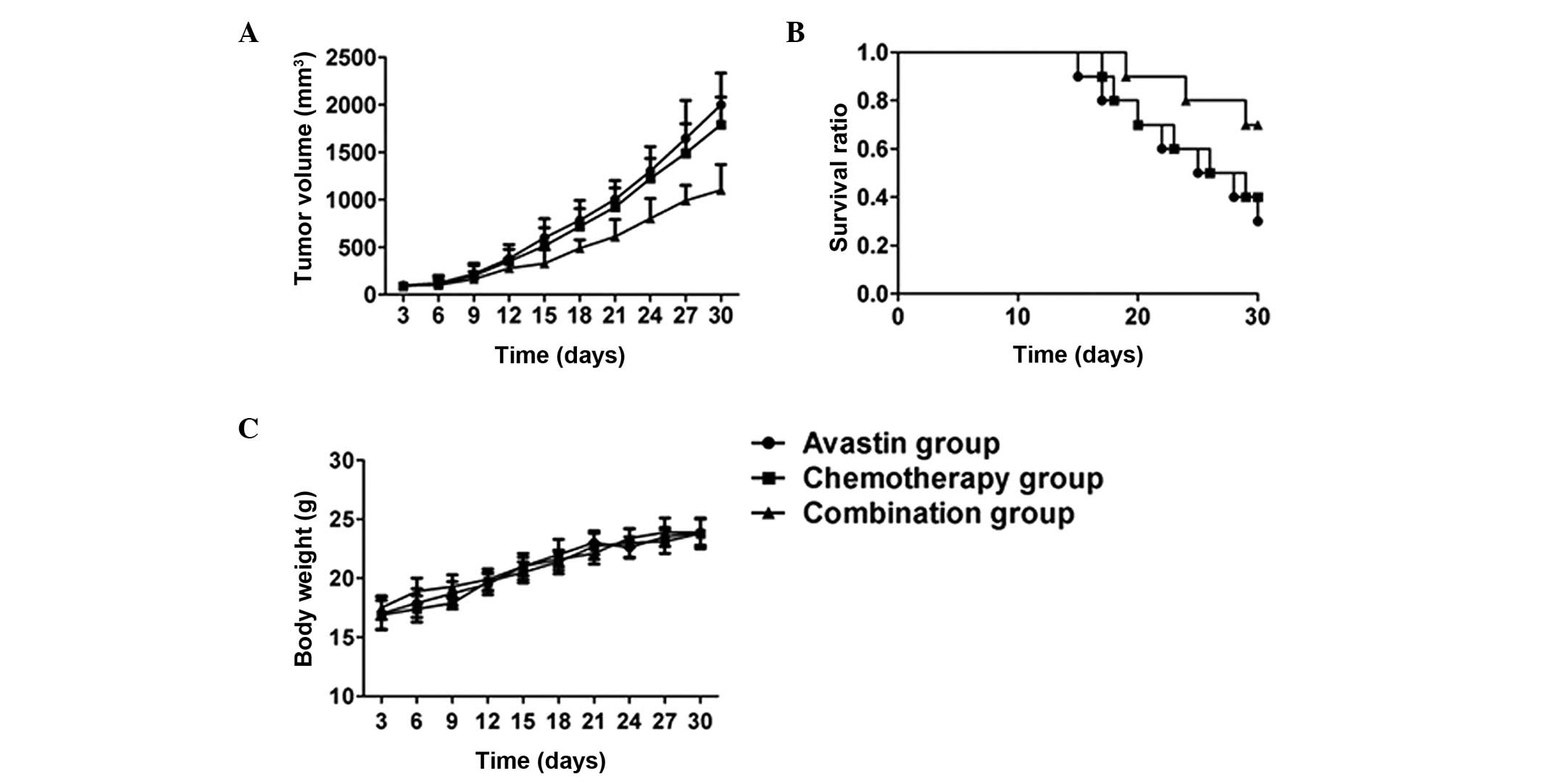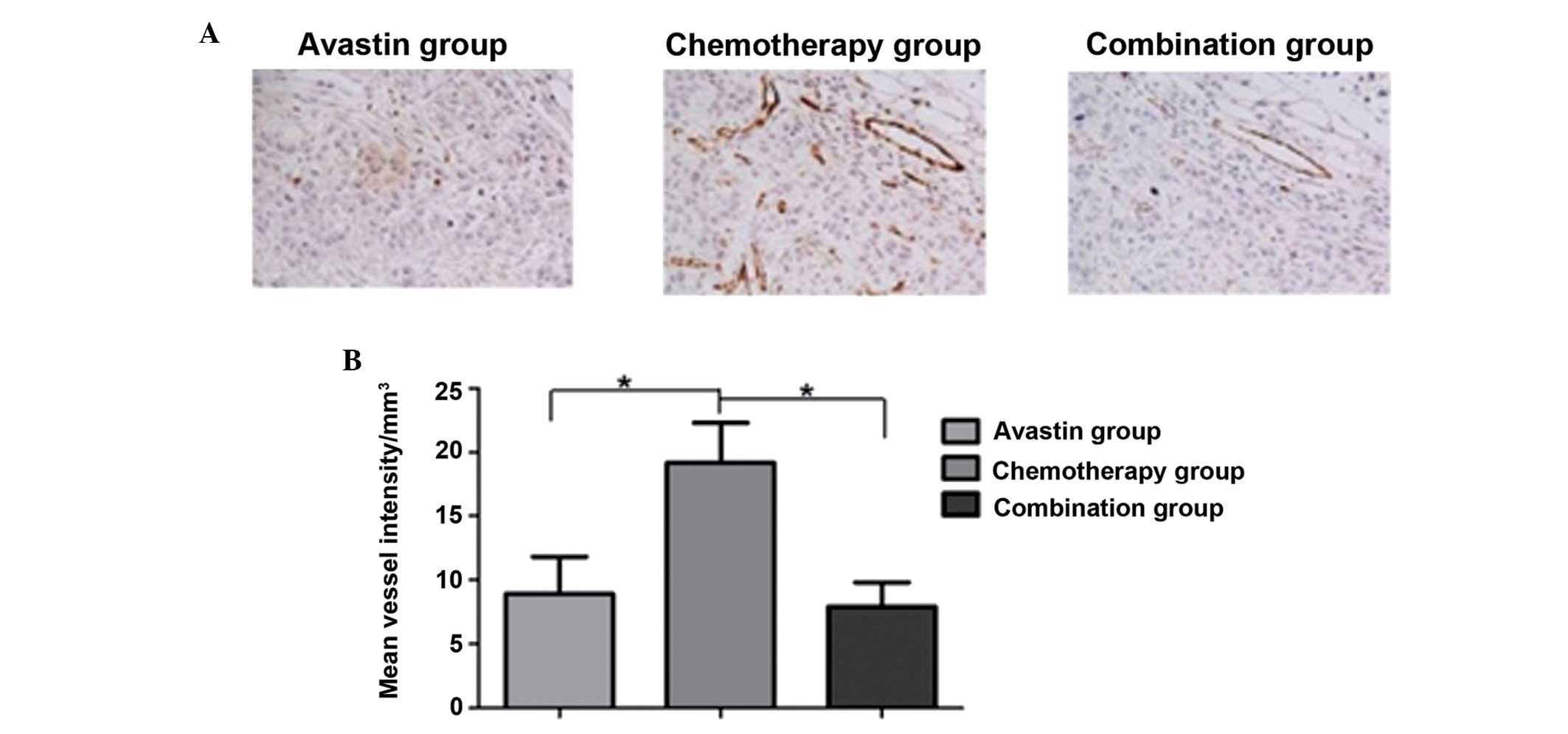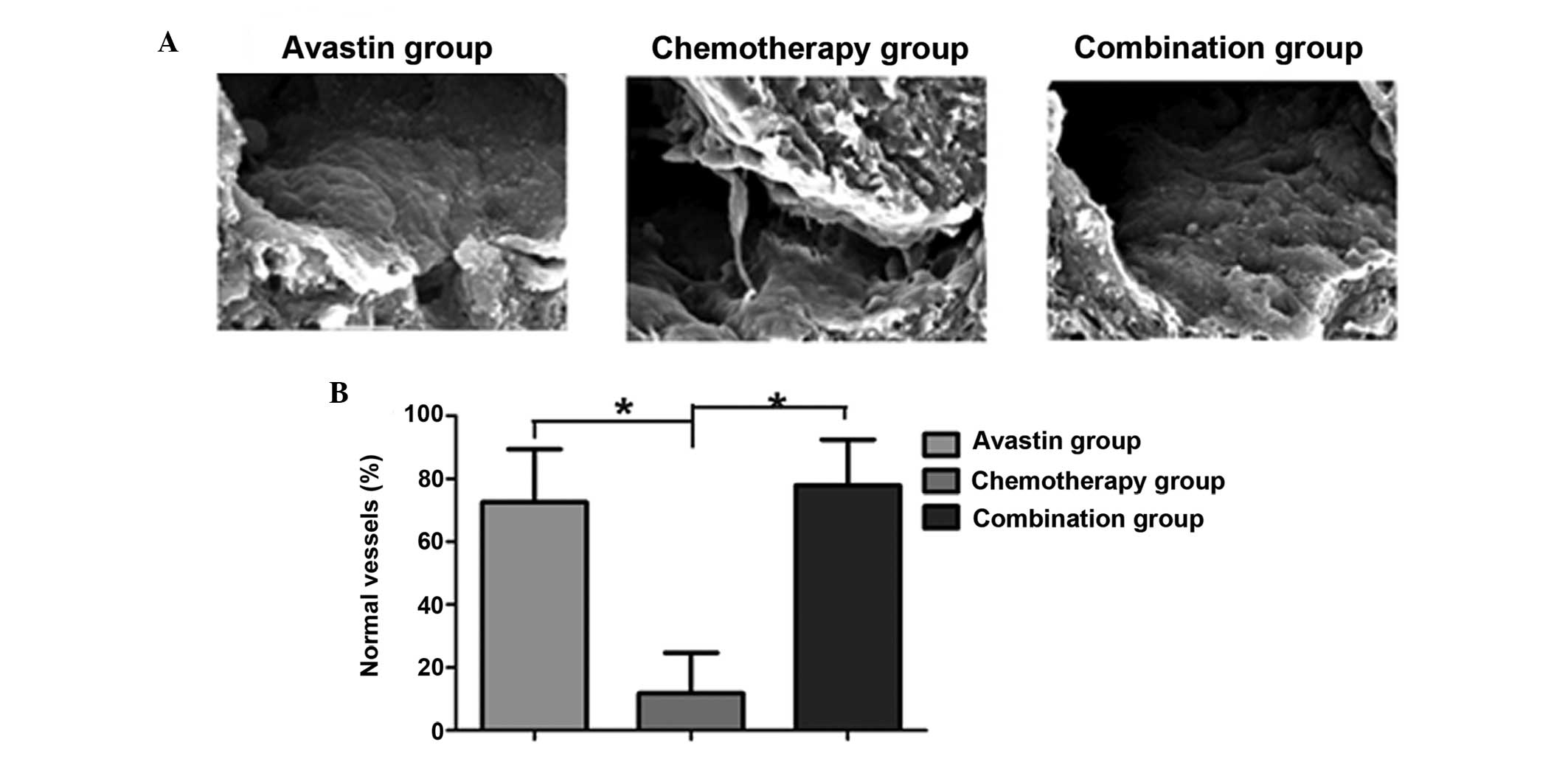Avastin® in combination with gemcitabine and cisplatin significantly inhibits tumor angiogenesis and increases the survival rate of human A549 tumor-bearing mice
- Authors:
- Published online on: April 1, 2015 https://doi.org/10.3892/etm.2015.2402
- Pages: 2180-2184
Abstract
Introduction
Lung cancer is a common clinical malignancy. In recent years, the incidence rate of the disease has shown a marked increasing trend, and the condition has become a major threat to human health (1). Approximately 85% of patients with lung cancer suffer from non-small cell lung cancer; therefore, the treatment of non-small cell lung cancer has become a particular research focus (2,3). Chemotherapy, including gemcitabine plus cisplatin (GP) and paclitaxel plus cisplatin regimens, is the most commonly used treatment for non-small cell lung cancer (4,5); however, the prognosis of patients receiving pure chemotherapy is worse compared with the prognosis following a combined chemotherapy regimen such as GP. In recent years, with the development of molecular targeted therapy, the combined utilization of antineoplastic therapy with chemotherapy, taking tumor vessels as the main treatment target, has had a significant effect in the clinic (6,7). Angiogenesis is the process of new blood vessel formation, which is an essential process during wound healing. In addition, angiogenesis is regulated by the extremely sensitive interaction of certain growth factors and inhibitors. Avastin®, a recombinant humanized monoclonal antibody, is the first inhibitor of tumor angiogenesis to be approved in America. Several clinical studies have shown that Avastin exhibits good efficacy in the treatment of non-small cell lung cancer (8,9). Our clinical experience has indicated that the curative effect of a combinatorial Avastin and GP treatment regimen is superior to the separate curative effects of the drugs; however, the mechanism of this phenomenon is not fully understood. The aim of the present study, therefore, was to analyze the mechanism of Avastin combined with a GP regimen in the treatment of non-small cell lung cancer in an animal model, in order to provide a theoretical basis for clinical practice.
Materials and methods
Model construction and drug treatment
Balb/c nude mice were purchased from the Beijing Academy of Military Medical Sciences (Beijing, China). The mice were 7 weeks old, weighed 19–20 g, and were raised in a specific pathogen free animal house. This study was carried out in strict accordance with the recommendations in the Guide for the Care and Use of Laboratory Animals of the National Institutes of Health. The animal use protocol was reviewed and approved by the Institutional Animal Care and Use Committee of the Second Affiliated Hospital of Zhengzhou University (Zhengzhou, China).
A549 cells (The Type Culture Collection of the Chinese Academy of Sciences, Beijing, China) were grown in Dulbecco's modified Eagle's medium with 10% fetal bovine serum (Invitrogen Life Technologies, Carlsbad, CA, USA). Subsequent to reaching the exponential growth phase, the cells were digested using trypsin (Gibco-BRL, Grand Island, NY, USA) and washed twice with phosphate-buffered saline (PBS). The A549 cells were then resuspended in PBS buffer solution and the cell concentration was adjusted to 2×107/ml. Following the resuspension and concentration adjustment, the cells (2×106/100 µl) were inoculated in the fat pad close the armpit in the left rib of each mouse. The tumors were left to grow for 7–9 days to reach a volume of 100–150 mm3, and the tumor-bearing nude mice were then randomly divided into three groups: Avastin, chemotherapy and combined treatment (n=10/group). The mice in the Avastin group were administered an intraperitoneal injection of 5 mg/kg Avastin (Roche, Basel, Switzerland) every other day, 10 times in total. The mice in the chemotherapy group were administered an intraperitoneal injection of 4 mg/kg gemcitabine and 4 mg/kg cisplatin (Jiangsu Hansoh Pharmaceutical Inc., Lianyungang, China) every other day, 10 times in total. The mice in the combined treatment group were administered an intraperitoneal injection of 5 mg/kg Avastin and then, on the next day, an intraperitoneal injection of GP. The treatments were administered 10 times in total. During the course of each treatment, the tumor volume and weight were measured every two days, and the mortality rates of the mice were recorded.
Analysis of the level of vascular endothelial growth factor (VEGF) in the tumor tissue
The mice in the three groups were sacrificed following treatment for 10 days. A total of 0.1 g tumor tissue was obtained for tissue homogenization and cell lysis. This sample was then stood on ice and, after 30 min, centrifuged at 15,000 × g for 10 min. The supernatant was transferred to a new centrifuge tube and the concentration of total protein was determined. The expression level of VEGF in the tumor tissue was subsequently analyzed in accordance with the ELISA kit instructions (R&D Systems Inc., Minneapolis, MN, USA).
Analysis of tumor vessel density
Tumor tissue was embedded in paraffin and sliced into 6-µm sections. The sections were stuck on the slides. Each slide was dewaxed and washed with PBS three times, followed by treatment with a hydrogen peroxide scavenger, 3% catalase, and sodium citrate for antigen retrieval. The sample was subsequently blocked for 30 min using 1% goat serum (Gibco-BRL) at room temperature and excess liquid was sucked away. The monoclonal rat anti-mouse cluster of differentiation 31 (CD31) antibody (1:200; #MAB3420; Santa Cruz Biotechnology, Inc., Santa Cruz, CA, USA) was dripped onto the surface of the slide and incubated at 4°C overnight. The next day, the sample was placed at room temperature for 30 min and then washed with PBS three times (5 min/wash). The diluted secondary antibody (Santa Cruz Biotechnology, Inc.) was dripped onto the slide, incubated for 1 h at room temperature, washed three times with PBS and colored using 3,3′-diaminobenzidine for 5–10 min. The staining was observed under the microscope. The slides were rinsed with tap water for 5 min. Hematoxylin was used to the stain the nuclei and hydrochloric acid alcohol was used for differentiation. The samples were then dehydrated and clarified in 75, 80, 90, 95 and 100% ethanol and xylene successively. Finally, the slides were sealed with neutral resin. The vessel density was observed under an optical microscope (Leica Microsystems, Heidelberg, Germany).
Analysis of the morphological structure of tumor vessels
The mice in the three groups were sacrificed following 10 days of treatment. The tumor tissues were sliced into blocks measuring 3×3 µm and placed in 3% glutaraldehyde to fix for >2 h. Each sample was then washed with 0.1 mol/l phosphate buffer solution three times (5 min/wash) and dehydrated with a graded tert-butyl alcohol series (50, 70, 80, 90, 95 and 100%) for 15 min each time. The sample was subsequently dried using the critical drying method. The dry sample was attached to the slides using a conductive adhesive in preparation for the metal plating of the sample. The vascular morphology was directly observed under a scanning electron microscope (Agilent Technologies, Beijing, China).
Statistical analysis
All data were analyzed using SPSS 17.0 software (SPSS Inc., Chicago, IL, USA). The measurement data are presented as the mean ± standard error. The χ2 test was used to compare the count data. Multiple groups of measurement data were compared using analysis of variance. Paired comparisons between two groups were performed using the Least Significant Difference method. P<0.05 was considered to indicate a statistically significant difference.
Results
Combined treatment significantly inhibits tumor growth and improves the survival rate of mice
As shown in Fig. 1, no statistical difference was observed in the tumor growth curve between the Avastin and chemotherapy groups (P>0.05). The tumor growth curve in the combined treatment group was significantly lower than that in the Avastin and chemotherapy groups (P<0.05). The survival rate of the mice in the combined treatment group was significantly higher than that of the mice in the Avastin and chemotherapy groups (P<0.05). No significant difference in mouse bodyweight was found among the three groups during the treatment (P>0.05).
Avastin reduces the level of VEGF in tumor tissue
The standard curve of VEGF was established according to the instructions of the ELISA kit (R&D Systems Inc.). The standard curve was observed to have good linearity (r=0.998). Comparison of the level of VEGF in the tumor tissue showed that the levels in the Avastin and combined treatment groups were significantly lower than those in the separate chemotherapy group (P<0.05); however, no statistical difference in VEGF levels was observed between the Avastin and combined treatment groups (P>0.05) (Fig. 2).
Avastin significantly reduces the tumor vascular density
Immunohistochemical staining showed that the number of CD31-positive vessels in the Avastin and combined treatment groups was lower than that in the chemotherapy group; additionally, the tumor vessel density was higher in the chemotherapy group. The quantitative analysis showed that the number of vessels in the Avastin and combined treatment groups was significantly lower than that in the chemotherapy group (P<0.05); however, no statistical difference in vessel density was observed between the Avastin and combined treatment groups (P>0.05) (Fig. 3).
Avastin can promote the normalization of tumor vascular structure
The microstructure of the tumor vessels was analyzed through scanning electron microscopy. It was observed that the tumor tissue in the Avastin and combined treatment groups exhibited an integrated tumor vascular morphology; furthermore, the endothelial cells were noted to be tightly associated with the vessel wall. By contrast, the chemotherapy group exhibited an irregular tumor vascular morphology, and the endothelial cells were dissociated from the vessel wall. Quantitative analysis of the vessels in the tumor tissue in the three groups showed that the number of normal vessels in the tumor tissue in the Avastin and combined treatment groups was significantly higher than that in the chemotherapy group. The difference was statistically significant (P<0.05) (Fig. 4).
Discussion
In 1971, Folkman (10) found that, following the growth of the solid tumor volume to 1–2 mm3, tumor growth was dependent on ongoing oxygen and nutrients supplied by neovascularization. The time quantum of tumor metastasis was also closely associated with tumor angiogenesis; therefore, tumor vessels laid the material foundation for the tumor growth, invasion and metastasis (10–12). Antineoplastic therapy, taking tumor the vasculature as a target, was soon applied to clinical therapy. VEGF is the growth factor of vascular endothelial cells and plays an important role in mediating angiogenesis and formation (13). Effective inhibition of the activation of the VEGF signaling pathway can significantly inhibit the formation of angiogenesis (14). Based on this theory, Avastin has been the first used clinical humanized antibody drug targeting VEGF, and has shown a gratifying effect in numerous tumors when used separately to or combined with chemo- or radiotherapy (15).
Our clinical experience has indicated that the curative effect of Avastin in combination with chemotherapy is superior to that of Avastin or chemotherapy administered separately. Furthermore, this increase in curative effect was not a simple superposition of effect. The aim of the present study, therefore, was to study the cause of this phenomenon using an animal model. Similar findings to those obtained through clinical practice were observed in the animal experiments. One explanation is that Avastin significantly decreased the level of VEGF in the tumor tissue and downregulated the vascular density of the tumor tissue, while chemotherapy had a synergistic effect. As such, the combination of Avastin and chemotherapy significantly inhibited the growth of the tumor.
In the present study it was additionally observed that vessels in the tumor tissue exhibited marked abnormalities, with endothelial cell damage, exfoliation, an incomplete vascular wall and a loss of pericytes, resulting in a fall in the tumor vascular pressure and a retardation of blood flow. These characteristics led to the ineffective transportation of the chemotherapeutic drugs to the tumor tissue and reduced the tumoricidal effect (16–18). Jain proposed a vascular normalization theory, in which the normalization of the tumor vasculature was considered to be beneficial to enhance the antitumor effect (19). Based on this theory, the vascular morphology in the tumor tissue from mice subjected to different treatments was observed in the present study. It was found that the tumor vascular morphology underwent marked changes following treatment for 7 days with Avastin, and tended towards normalization. The normalization of tumor vessels can enable chemotherapeutic drugs to effectively reach the tumor tissue and kill the tumor cells (20–22). This phenomenon may explain the enhanced curative effect of the combinatorial Avastin and GP regimen in the treatment of tumors.
In conclusion, Avastin combined with chemotherapy has a good application prospect in the treatment of lung cancer. The clinical effect of the combinatorial strategy is significant and the mechanism of action is clear. The synergistic effect of the combined treatments makes the approach worthy of clinical application.
References
|
Siegel R, Naishadham D and Jemal A: Cancer statistics, 2012. CA Cancer J Clin. 62:10–29. 2012. View Article : Google Scholar : PubMed/NCBI | |
|
Goldstraw P, Ball D, Jett JR, Le Chevalier T, Lim E, Nicholson AG and Shepherd FA: Non-small-cell lung cancer. Lancet. 378:1727–1740. 2011. View Article : Google Scholar : PubMed/NCBI | |
|
Naim Younes R, Gross JL, Abrao FG and Rodrigues Pereira J: Impact of adjuvant chemotherapy in completely resected stage IIIA non-small cell lung cancer. Minerva Chir. 68:169–174. 2013.PubMed/NCBI | |
|
Reaume MN, Leighl NB, Mittmann N, et al: Economic analysis of a randomized phase III trial of gemcitabine plus vinorelbine compared with cisplatin plus vinorelbine or cisplatin plus gemcitabine for advanced non-small-cell lung cancer (Italian GEMVIN3/NCIC CTG BR14 trial). Lung Cancer. 82:115–120. 2013. View Article : Google Scholar : PubMed/NCBI | |
|
Arrieta O, Michel Ortega RM, Villanueva-Rodríguez G, et al: Association of nutritional status and serum albumin levels with development of toxicity in patients with advanced non-small cell lung cancer treated with paclitaxel-cisplatin chemotherapy: A prospective study. BMC Cancer. 10:502010. View Article : Google Scholar : PubMed/NCBI | |
|
De Falco S: Antiangiogenesis therapy: An update after the first decade. Korean J Intern Med. 29:1–11. 2014. View Article : Google Scholar : PubMed/NCBI | |
|
Dings RP, Loren M, Heun H, et al: Scheduling of radiation with angiogenesis inhibitors anginex and Avastin improves therapeutic outcome via vessel normalization. Clin Cancer Res. 13:3395–3402. 2007. View Article : Google Scholar : PubMed/NCBI | |
|
Suzuki H, Hirashima T, Kobayashi M, et al: Carboplatin plus paclitaxel in combination with bevacizumab for the treatment of adenocarcinoma with interstitial lung diseases. Mol Clin Oncol. 1:480–482. 2013.PubMed/NCBI | |
|
Tsimberidou AM, Adamopoulos AM, Ye Y, et al: Phase I clinical trial of bendamustine and bevacizumab for patients with advanced cancer. J Natl Compr Canc Netw. 12:194–203. 2014.PubMed/NCBI | |
|
Folkman J: Tumor angiogenesis: Therapeutic implications. N Engl J Med. 285:1182–1186. 1971. View Article : Google Scholar : PubMed/NCBI | |
|
Dimova I, Popivanov G and Djonov V: Angiogenesis in cancer - general pathways and their therapeutic implications. J BUON. 19:15–21. 2014.PubMed/NCBI | |
|
Harper J and Moses MA: Molecular regulation of tumor angiogenesis: Mechanisms and therapeutic implications. EXS. 96:223–268. 2006.PubMed/NCBI | |
|
Adams RH and Alitalo K: Molecular regulation of angiogenesis and lymphangiogenesis. Nat Rev Mol Cell Biol. 8:464–478. 2007. View Article : Google Scholar : PubMed/NCBI | |
|
Tunik S, Nergiz Y, Keklikci U and Akkus M: The subconjunctival use of cetuximab and bevacizumab in inhibition of corneal angiogenesis. Graefes Arch Clin Exp Ophthalmol. 250:1161–1167. 2012. View Article : Google Scholar : PubMed/NCBI | |
|
Keunen O, Johansson M, Oudin A, et al: Anti-VEGF treatment reduces blood supply and increases tumor cell invasion in glioblastoma. Proc Natl Acad Sci USA. 108:3749–3754. 2011. View Article : Google Scholar : PubMed/NCBI | |
|
Teicher BA: A systems approach to cancer therapy. (Antioncogenics + standard cytotoxics → mechanism(s) of interaction). Cancer Metastasis Rev. 15:247–272. 1996. View Article : Google Scholar : PubMed/NCBI | |
|
Wouters BG and Brown JM: Cells at intermediate oxygen levels can be more important than the ‘hypoxic fraction’ in determining tumor response to fractionated radiotherapy. Radiat Res. 147:541–550. 1997. View Article : Google Scholar : PubMed/NCBI | |
|
Powathil GG, Adamson DJ and Chaplain MA: Towards predicting the response of a solid tumour to chemotherapy and radiotherapy treatments: Clinical insights from a computational model. PLoS Comput Biol. 9:e10031202013. View Article : Google Scholar : PubMed/NCBI | |
|
Jain RK: Normalizing tumor vasculature with anti-angiogenic therapy: A new paradigm for combination therapy. Nat Med. 7:987–989. 2001. View Article : Google Scholar : PubMed/NCBI | |
|
Batchelor TT, Sorensen AG, di Tomaso E, et al: AZD2171, a pan-VEGF receptor tyrosine kinase inhibitor, normalizes tumor vasculature and alleviates edema in glioblastoma patients. Cancer Cell. 11:83–95. 2007. View Article : Google Scholar : PubMed/NCBI | |
|
Hormigo A, Gutin PH and Rafii S: Tracking normalization of brain tumor vasculature by magnetic imaging and proangiogenic biomarkers. Cancer Cell. 11:6–8. 2007. View Article : Google Scholar : PubMed/NCBI | |
|
Sorensen AG, Batchelor TT, Zhang WT, et al: A ‘vascular normalization index’ as potential mechanistic biomarker to predict survival after a single dose of cediranib in recurrent glioblastoma patients. Cancer Res. 69:5296–5300. 2009. View Article : Google Scholar : PubMed/NCBI |













